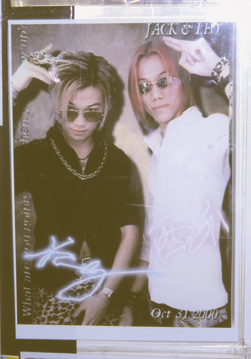Alienated for being unfashionable
‘Mongkok people’ are marginalized by their peer

Two ‘Mk people’, Jack and Leo, pose for an instant-card photo in — where else? — a Mongkok shop. (Jeanne Luk)
By Jeanne Luk
‘They have bad taste. They buy fake stuff. They are rude. They are brash. They are underachievers,” said Stephanie Chan, a Year 3 marketing major at Baptist University.
She has a bad impression of “Mongkok people” — or “Mk people”, as they are sometimes known — even though she has never come into contact with them. She shuns them because she “knows they are bad just by looking at them”.
Cherie Chung, a Form 6 student at Caritas Shatin Marden Foundation Secondary School, also does not want to befriend any “Mk people”.
Ms. Chung said, “They are terrible. I immediately walk away if they come near me.”
Though she does not know any “Mk people”, she has only bad comments for them. She believes that “Mk people” engage in illegal activities, such as selling pirated CDs.
“Mk people” is a derogatory term used to describe certain youths who hang out in Mongkok and share similar behavioral characteristics.
Ms. Chan and Ms. Chung describe “Mk people” as those who punctuate their sentences with profanities. Their hair resembles an artists’ palette, dyed with streaks of gold, blue and purple.
Bottle Shiu, chairperson of the Hong Kong Policy Viewers, said, “The term ‘Mk people’, is a term created by young people to designate the stratification levels of youths.
“It is not a ‘real’ social group, but a mere label.
“We usually classify people in society into the upper class, middle class and lower class.
“However, youths are unaware of such social classifications. They use another stratification system instead.”
In Hong Kong, Mr. Shiu said, youths classify each other into the Causeway Bay class, Tsim Sha Tsui class or Mongkok class.
People in the Causeway Bay class are looked upon as the upper class.
Hanging out usually in Causeway Bay, youths in this class are regarded as trendy and hip.
According to Mr. Shiu, teenage magazines shoot photos of “trendy people” in Causeway Bay. This gives the impression that people in Causeway Bay are the most fashionable.
“Goods in Causeway Bay are more expensive than elsewhere, and most of the shops there feature famous brands and designer clothes. This adds a prestigious feeling to the young people who shop and hang out there,” said Mr. Shiu.
The Tsim Sha Tsui class represents the middle class of Hong Kong youths.
Tsim Sha Tsui offers more variety in terms of pricing and brands.
Finally, the Mongkok class represents the lowest social status.
Mr. Shiu said, “When we talk about Mongkok, we immediately think of cheap clothes and fake goods.
“Thus, young people who spend a lot of their free time there are regarded by their peers as being tasteless.”
According to Mr. Shiu, this stratification is a consensus among youths. Though the rules of classification are seldom discussed explicitly, they are strictly followed.
Mr. Shiu said that there are two reasons why youths look down on “Mk people”.
First, they want to show their superiority and establish their own status by margi-nalizing “Mk people”.
Ms. Cheung added, “With a marginalized sub-culture, mainstream youths can clearly define themselves.”
She said that this act of marginalizing a particular group is not new.
“For example, in the 1980s we had the ‘Grease’ group, which was also considered a deviant from the mainstream.”
Mr. Shiu used “Mk phobia” to explain youths’ rejection of “Mk people”.
Afraid of being seen as a “Mk person”, youths alienate “Mk people” to show that they are not one of them.
Therefore, Mr. Shiu said, the very people that youths regard as “Mk people” deny such an identity.
“They may even instigate agitation against ‘Mk people’.”
Cheung Wai Ting, instructor in the Department of Sociology at The Chinese University of Hong Kong, said that youths are not the only ones who have negative impressions of “Mk people”.
Adults are also biased against youths who dress outlandishly.
Au Fung Chan of Wong Tai Sin is a 49-year-old housewife with two daughters.
She said, “Those kids in black clothes with gold hair are bad guys. I always tell my daughters to be wary of them.”
Ms. Cheung said, “People do not regard adults’ wearing unusual clothes as a problem.
“But when young people dress in an unorthodox way and dye their hair, we consider them as bad elements of society.
She added, “The stereotype is based on the values of middle class.
“When young people deviate from middle class expectations, adults presume that the youths are in the wrong.”
Agreeing, Mr. Shiu said, “Hong Kong people divide youngsters into two groups, either good or bad. There is no in-between.
“People attribute all negative elements in society to the ‘bad’ youths.”
However, contrary to common belief, “Mk people” may not necessarily be bad elements in society.
Rather, they may simply be young people who lack the money to lavish on expensive clothing.
Mr. Shiu said some young people may dress the “Mk” way because they lack the money to buy trendy clothes, but still want to follow trends.
“Therefore, they can only be copycats,” said he.
He believes a youth’s allowance is what creates the distinction between the Mongkok class and Causeway Bay class.
Ms. Cheung said, “It seems unfair to judge these young people as ‘bad’ youths.”
However, the stereotype seems deeply rooted in people’s minds.
Summing it up, Ms. Chan, the university student, said, “Boiled down to one sentence — they are bad.”